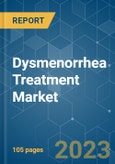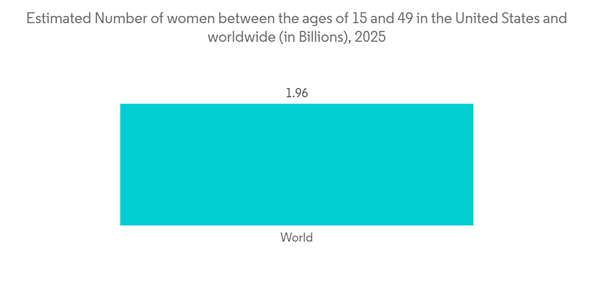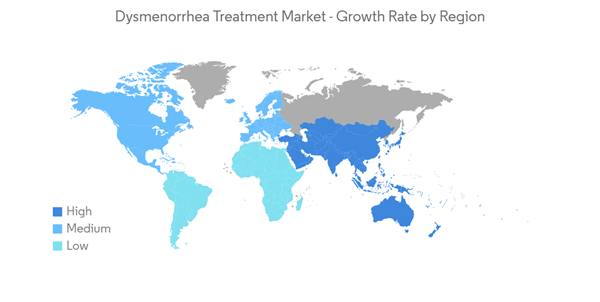COVID-19 was an unprecedented health concern affecting millions physically and mentally. The pandemic significantly impacted many people's mental health, resulting in loneliness, social isolation, financial strain, anxiety and fear of contracting the virus, and uncertainty for the future. It has been proven that periods of stress and psychological distress can affect a woman’s menstrual health. Stressors can activate the hypothalamic-pituitary-gonadal (HPG) axis and alter the neuro-modulatory cascade that drives gonadotropin, releasing hormone (GnRH) regulation, which results in an irregular menstrual cycle. The changes in menstrual cycles lead to higher episodes of dysmenorrhea, significantly impacting the market.
According to a study published in March 2021 by Frontiers in Endocrinology, 46% of women reported a change in their menstrual cycle, with 30% of new dysmenorrhea cases since the pandemic began. Thus, COVID-19 had an impact on the dysmenorrhea treatment market significantly. Even after the pandemic, the market is expected to see a surge over the forecast period with increasing cases of dysmenorrhea and rising research and development.
Dysmenorrhea is commonly known as menstrual cramps, which affects women. The key factors attributed to driving the market growth are the increasing prevalence of dysmenorrhea among adolescent girls and rising cases of menstrual cramps due to genetic disorders. As per the study published in March 2022 by BMC Women's Health, the observed dysmenorrhea in the study; 1107 (92.3%) women had non-pathological dysmenorrhea (primary) while 92 (7.7%) women had pathological dysmenorrhea (secondary) respectively. Moreover, as per a study published in February 2021 by BMJ Open, dysmenorrhea was a common health problem among graduating university students. The prevalence of dysmenorrhea was 317 (51.5%) in Ethiopia. The educational status of the father, chocolate consumption (95%), daily breakfast intake (less than 5 days/week), irregular menstrual cycle, and positive family history of dysmenorrhea, had a statistically significant association with dysmenorrhea. Thus, the increasing burden of dysmenorrhea is expected to boost the growth of the market over the forecast period.
Moreover, increasing research and development for developing innovative drugs is expected to boost the growth of the market. As per a study published in July 2021 by the Journal of Clinical Medicine, various combinations of non-steroidal anti-inflammatory drugs (NSAIDs) and spasmolytics have been developed and tested, demonstrating a huge potential for future research to develop modern, effective combinations and search for new indications for the existing fixed-dose combination drugs for treating dysmenorrhea. Thus, research studies highlighting the potential of existing treatments for menstrual cramps and developing new drugs may drive the market.
However, side effects and complications associated with long-term treatment and lack of awareness about reproductive health in women are expected to restrain the market’s growth during the forecast period.
Dysmenorrhea Treatment Market Trends
The Non-steroidal Anti-inflammatory Drugs Segment is Expected to Hold a Major Market Share in the Dysmenorrhea Treatment Market
Over-the-counter pain relievers, such as ibuprofen (Advil, Motrin IB, others) or naproxen sodium (Aleve), at regular doses starting the day before you expect your period to begin can help control the pain of cramps. Some of the US FDA-approved NSAIDs for the treatment of dysmenorrhea are diclofenac, ibuprofen, ketoprofen, meclofenamate, mefenamic acid, and naproxen.According to an article published in the Women's Health Concern and British Menopause Society in December 2020, approximately 80% of dysmenorrhea women experience period pain at some stage in their lifetime. In 40% of women, period pain is accompanied by premenstrual symptoms, such as bloating, tender breasts, swollen stomach, lack of concentration, mood swings, clumsiness, and tiredness. Therefore, dysmenorrhea should be treated in its early days, which is expected to increase the usage of NSAIDs and drive the segment’s growth.
Additionally, as per a research article by UpToDate last updated in February 2022, NSAIDs can more effectively treat dysmenorrhea-related pain. Approximately 80 trials reported that NSAIDs were more effective than placebo for patients with primary dysmenorrhea. In August 2022, Bayer demonstrated the data showing that a single maximum non-prescription dose of Aleve (naproxen sodium) provided more pain relief over 12 hours than acetaminophen for menstrual cramps due to primary dysmenorrhea. Thus, the high efficacies of NSAIDs are readily driving the adoption rate of NSAIDs, which may boost the market’s growth.
Moreover, the prevalence of diseases such as endometriosis, which is the leading cause of secondary dysmenorrhea, is also rising globally. According to an article published in July 2021 by WebMD, endometriosis affects an estimated 1 in 10 women during their reproductive years, which is approximately 176 million women worldwide. This factor is expected to have a significant impact on the market’s growth.
North America is Expected to Hold a Significant Share in the Market During the Forecast Period
North America is expected to hold a major market share in the dysmenorrhea treatment market. The United States is expected to contribute to this growth significantly due to the increasing incidence and prevalence of dysmenorrhea and awareness of dysmenorrhea among women. According to the statistics published in November 2020, Simmons Winter NHCS 12-Month, 31.31 million women in the US reported menstrual / period pain or pre-menstrual syndrome (PMS) in 2020.Moreover, the launch of new products for treating the pain associated with primary and secondary dysmenorrhea is also driving the studied market. For instance, in May 2021, it was announced that the U.S. FDA approved Myfembree (relugolix 40 mg, estradiol 1 mg, and norethindrone acetate 0.5 mg), the first once-daily treatment for the management of heavy menstrual bleeding associated with uterine fibroids in premenopausal women, with a treatment duration of up to 24 months.
Dysmenorrhea Treatment Market Competitor Analysis
The dysmenorrhea treatment market is competitive and consists of several major players. Some of the major players include Novartis AG, Bayer AG, Abbott Laboratories, F. Hoffmann-La Roche Ltd, Sanofi, Pfizer Inc., GlaxoSmithKline PLC, Focus Consumer Healthcare, Johnson & Johnson, and Alvogen.Additional benefits of purchasing the report:
- The market estimate (ME) sheet in Excel format
- 3 months of analyst support
This product will be delivered within 2 business days.
Table of Contents
Companies Mentioned (Partial List)
A selection of companies mentioned in this report includes, but is not limited to:
- Novartis AG
- Bayer AG
- Abbott Laboratories
- F. Hoffmann-La Roche Ltd
- Sanofi
- Pfizer Inc
- GlaxoSmithKline PLC
- Focus Consumer Healthcare
- Johnson & Johnson
- Alvogen










